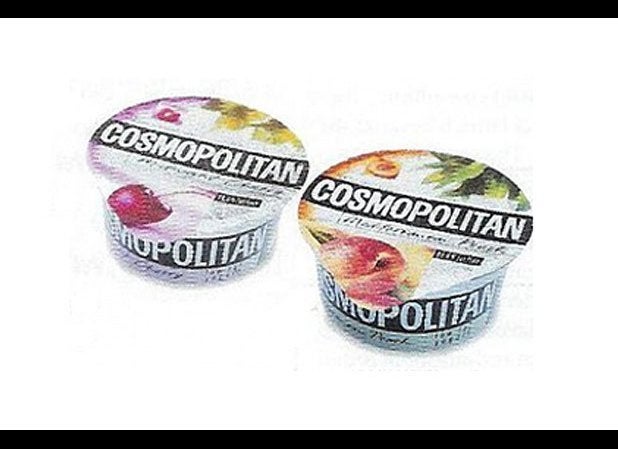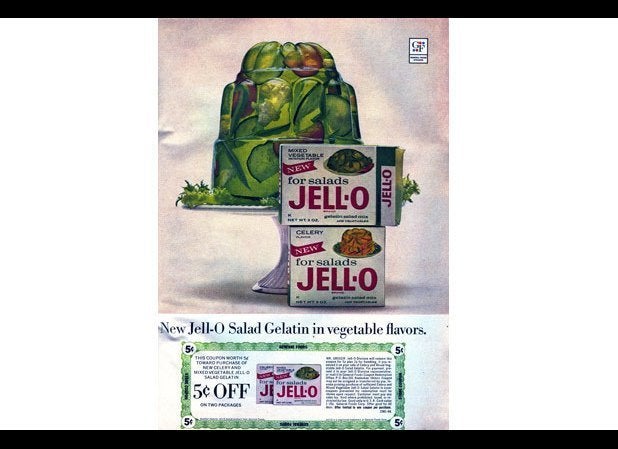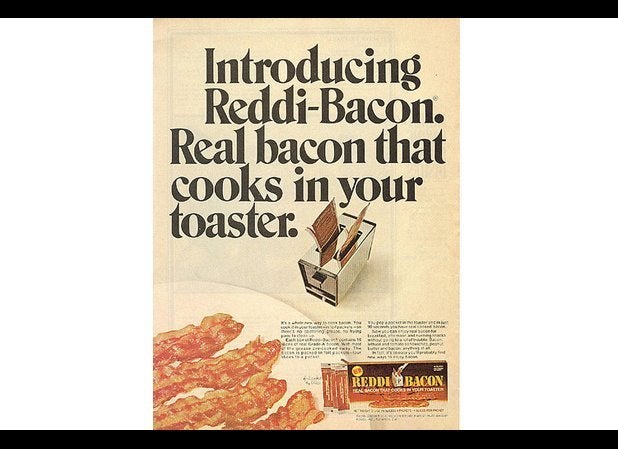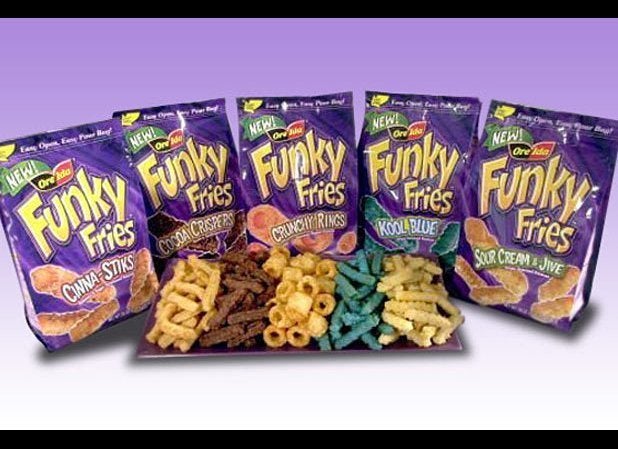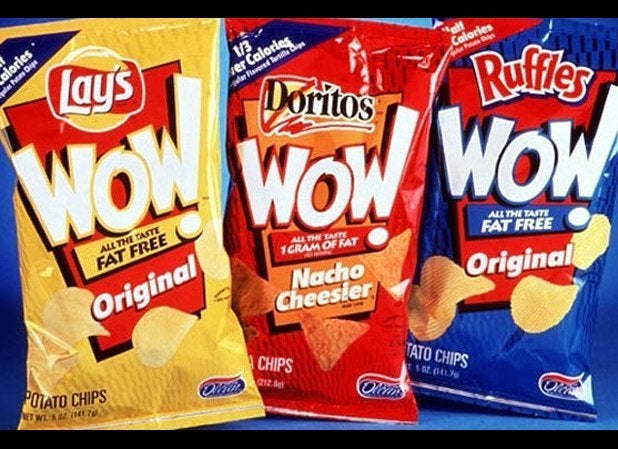When we go to the supermarket, we have certain expectations of the products that we'll see there. For example, ketchup will be red, not purple. Jell-O will not be celery-flavored. Life Savers will be little round candies, not soda. When these expectations are turned on their heads, not only is there a bit of cognitive dissonance, it's just bizarre. And it's not until the shock wears off that we actually ask ourselves, "Why would anyone possibly want to buy this?"
Brand extensions, or when a company rolls out a new product that's still connected to their core brand, are a mainstay of the food product industry. Most are well-thought-out, field tested, and happen to make a lot of sense: Oscar Mayer's known for its lunch meat, so why not buy little rounds of their turkey, with cheese, crackers, a drink, and dessert, all packaged up in a tidy box? Lunchables were a hit when they were rolled out in 1988 for that very reason: it made sense, and parents trusted that the brand would be able to provide a decent, complete lunch for their kid. However, while the brand extensions we'll be taking a look at today might have made sense to some exhausted brand development executive somewhere, they certainly weren't hits with the general public.
Colgate Kitchen Entrees
We suppose the idea behind Colgate Kitchen Entrees was the fact that you’d eat the Colgate frozen dinner and then brush your teeth with Colgate toothpaste, but this one just simply didn’t work. The frozen food market was already pretty saturated when these dinners were released in 1982, and when people think of Colgate they tend to think of clean teeth, not frozen Swedish meatballs.
Click Here to see More Humiliating and Hilarious Food and Drink Product FailsPhoto Credit: Colgate Cosmopolitan Yogurt
This one is more of a brand crossover than a brand extension, but it's still a very strange one. In 1999, the folks at Cosmopolitan magazine had an idea: they’d get into the food game. While it’s unclear exactly what motivated them to release Cosmo-branded yogurt (women like Cosmo, women like yogurt, so women would like Cosmo yogurt, maybe?), there it was, on the shelves. And there it went, in the blink of an eye. Photo Credit: Cosmopolitan
Jell-O for Salads
It might be tough to believe, but there was a time in American history when so many people were making Jell-O-based salads that the company felt compelled to release a product that was specifically intended to encase vegetables. Ads for celery-flavored Jell-O showed elaborate Bundt-style molds of green Jell-O, with everything from pecans to tomato wedges to olives, cucumber, tuna, and hard-boiled eggs suspended within. But it wasn’t just celery though, the brand also released mixed vegetable, seasoned tomato, and Italian Jell-Os. Thankfully we’ve come far enough as a society that savory Jell-O is no longer a thing.
Photo Credit: © Flickr / wandering_magpieClick Here to see More Humiliating and Hilarious Food and Drink Product FailsReddi-Bacon
Lamb bacon is quickly becoming very popular, and is on the menu at New York’s new Bar Bacon as well as at Brooklyn’s famed butcher shop The Meat Hook. Lamb bellies are quite small, so The Meat Hook rolls theirs up like pancetta, with tasty results. Indianapolis-based The Smoking Goose also sells and ships lamb bacon, hot smoked over applewood after being rubbed with salt, brown sugar, and maple sugar. It’s rich, strong on lamb flavor, and cooks up just as nicely as pork bacon, so if you like lamb you’ll most likely love this. Heck, we’ll go so far as to predict that within a year lamb bacon really takes off.
Photo Credit: © Flickr / daves cupboard Funky Fries
For one brief, shining moment in 2002 and 2003, not only was it possible to eat fries with blue ketchup, it was possible to eat blue fries with blue ketchup. For some strange reason, Ore-Ida got it into their heads that kids really wanted to be able to eat blue French fries, as well as ones that came in flavors like cinnamon and chocolate. Even though millions of dollars were sunk into these new products, they completely tanked. You just don’t mess with American classics. Photo Credit: Heinz
Frito Lay’s WOW Chips
It sounded almost too good to be true: An alternative to oil, in which chips and other greasy snacks could be fried but would take on almost no fat and calories! When Frito-Lay rolled out a new line of WOW! chips that had been fried in the stuff, called olestra, in 1998, folks went crazy for it, until they realized that it had some, shall we say, unpleasant side effects, including abdominal cramping, diarrhea, and, yes, anal leakage. The Food and Drug Administration forced the company to plaster a warning label on all the products that contained the chemical, and sales immediately dropped off to near-zero. While the WOW! tag is long-gone, you can still find olestra in several of Frito-Lay’s "Light" products, including Tostitos, Lay’s, Ruffles, and Doritos.
Photo Credit: Frito-Lay Click Here to see More Humiliating and Hilarious Food and Drink Product FailsFor some expertise on why food products fail, we reached out to Christopher Cornyn, the president of DINE, an agency called upon by major brands when they're looking to roll out new products.
"Creating a new food product is complex," Cornyn told us. "Today, you must satisfy up to five consumer need states. You have to take into consideration a consumer's functional, nutritional, emotional, social, and cultural needs. Ten years ago, you only had to satisfy one or two and you had a hit. Now inventing a new food product requires a holistic approach that addresses all of these."
While it might appear as if a food product's failure or success hinges simply on whether it tastes good or not, that's actually just the tip of the iceberg.
"The number one reason why food products fail is that companies don't focus on the strategy of positioning and packaging," Cornyn added. "Just because a food product tastes great doesn't mean you will have a runaway success. Simply put, the package is the product. Packaging does all the work. A food package protects, preserves, transports, gets attention, communicates, builds image, facilitates, instructs, educates, reminds, and should also have a secondary life. This is lost on many new product introductions."
If all of this sounds incredibly complex and psychological, that's because it is. While a vast amount of thought and resources go into every single food product that's released, there's no way to predict whether it will do well or not, for one reason:
"Food products fail because it is impossible to anticipate consumers' needs, wants and desires," Cornyn said. "Humans are complex."
Most of these failed products were trying to capitalize on a trend. There was a time when people made salads (with actual vegetables) that were firmly encased in Jell-O. So why not sell celery-flavored Jell-O? Back in the early '00s, when everything was taken to the "EXXXXTREME," the folks at Heinz thought that it would be super-extreme to roll out a line of ketchups in "extreme" colors like green and purple. And during the free-spirited '70s, when people were living the single-and-ready-to-mingle life, Gerber assumed that they'd be just as willing to eat what looked like baby food out of a little glass jar.
While the board room honchos and field testers might think that an idea is a good one (although we can't imagine that anyone actually believed that that last product, called Gerber Singles, would be a hit), there's really no way to know if a product will sell until it hits the shelves. Some of these brand extensions, like Lunchables, are still with us today, and others, like Lunchables' "Maxed Out," which was targeted toward adults and contained 40 percent more food, fell off the shelves almost immediately.
Thankfully, most of the products that ended up in the trash heap and remain an embarrassing stain on the reputation of the brands that produced them are gone but not forgotten. And hopefully they never will be forgotten, because some of these are damn hilarious.
More Content from The Daily Meal:
Our 2024 Coverage Needs You
It's Another Trump-Biden Showdown — And We Need Your Help
The Future Of Democracy Is At Stake
Our 2024 Coverage Needs You
Your Loyalty Means The World To Us
As Americans head to the polls in 2024, the very future of our country is at stake. At HuffPost, we believe that a free press is critical to creating well-informed voters. That's why our journalism is free for everyone, even though other newsrooms retreat behind expensive paywalls.
Our journalists will continue to cover the twists and turns during this historic presidential election. With your help, we'll bring you hard-hitting investigations, well-researched analysis and timely takes you can't find elsewhere. Reporting in this current political climate is a responsibility we do not take lightly, and we thank you for your support.
Contribute as little as $2 to keep our news free for all.
Can't afford to donate? Support HuffPost by creating a free account and log in while you read.
The 2024 election is heating up, and women's rights, health care, voting rights, and the very future of democracy are all at stake. Donald Trump will face Joe Biden in the most consequential vote of our time. And HuffPost will be there, covering every twist and turn. America's future hangs in the balance. Would you consider contributing to support our journalism and keep it free for all during this critical season?
HuffPost believes news should be accessible to everyone, regardless of their ability to pay for it. We rely on readers like you to help fund our work. Any contribution you can make — even as little as $2 — goes directly toward supporting the impactful journalism that we will continue to produce this year. Thank you for being part of our story.
Can't afford to donate? Support HuffPost by creating a free account and log in while you read.
It's official: Donald Trump will face Joe Biden this fall in the presidential election. As we face the most consequential presidential election of our time, HuffPost is committed to bringing you up-to-date, accurate news about the 2024 race. While other outlets have retreated behind paywalls, you can trust our news will stay free.
But we can't do it without your help. Reader funding is one of the key ways we support our newsroom. Would you consider making a donation to help fund our news during this critical time? Your contributions are vital to supporting a free press.
Contribute as little as $2 to keep our journalism free and accessible to all.
Can't afford to donate? Support HuffPost by creating a free account and log in while you read.
As Americans head to the polls in 2024, the very future of our country is at stake. At HuffPost, we believe that a free press is critical to creating well-informed voters. That's why our journalism is free for everyone, even though other newsrooms retreat behind expensive paywalls.
Our journalists will continue to cover the twists and turns during this historic presidential election. With your help, we'll bring you hard-hitting investigations, well-researched analysis and timely takes you can't find elsewhere. Reporting in this current political climate is a responsibility we do not take lightly, and we thank you for your support.
Contribute as little as $2 to keep our news free for all.
Can't afford to donate? Support HuffPost by creating a free account and log in while you read.
Dear HuffPost Reader
Thank you for your past contribution to HuffPost. We are sincerely grateful for readers like you who help us ensure that we can keep our journalism free for everyone.
The stakes are high this year, and our 2024 coverage could use continued support. Would you consider becoming a regular HuffPost contributor?
Dear HuffPost Reader
Thank you for your past contribution to HuffPost. We are sincerely grateful for readers like you who help us ensure that we can keep our journalism free for everyone.
The stakes are high this year, and our 2024 coverage could use continued support. If circumstances have changed since you last contributed, we hope you'll consider contributing to HuffPost once more.
Already contributed? Log in to hide these messages.

